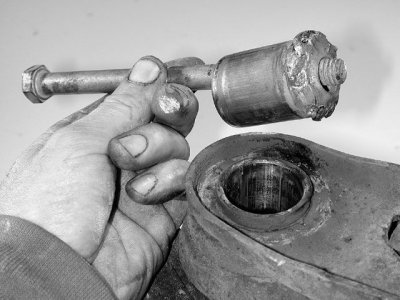1967coronet440
Well-Known Member
Ha I wishAre you kidding me !?!?! It takes like 10 minutes to do them that way !!
Ha I wishAre you kidding me !?!?! It takes like 10 minutes to do them that way !!
That's what I was referring to, inner sleeves, or shells on the shaft itself were a piece of cakeLets be clear about which "shells". The ones on the shafts are the one's you whack off with hammer and chisel. The outer shells which tend to remain in the LCA are easiest to remove by welding a washer on and pressing them out - which also only takes a few minutes.

I agree, there would be no way maintain my ride height it is spinning inside there.
I don't mean to criticize, because I don't know, but shouldn't the shaft have a positive lock like the factory ones? Is this something you have knowledge about? Again not criticizing, just trying to figure this out.This is not true. The bushing is just a pivot and insulator. The ride height is maintained by the adjuster and torsion bar. The "advantage" to the poly pieces is a) they are much harder than stock so will firm things up and b) because they spin freely they allow the suspension to move freely.
With stock bushings you have to adjust your ride height before tightening the LCA pivot nuts. With the polys you don't (because they turn freely).
If the polys were firmly attached as the stockers are you could probably do away with torsion bars altogether simply because the poly is so much stiffer than rubber.
I don't mean to criticize, because I don't know, but shouldn't the shaft have a positive lock like the factory ones? Is this something you have knowledge about? Again not criticizing, just trying to figure this out.
then tighten the pivot shaft nut with weight of car on suspension.
Boy your doing it the hard way, I use a die grinder and grind the shell in half.Keep in mind if you use the profirged kit you will have to remove the old outer shell, which is a PITA. Mancini makes a tool to remove them, took me 4 hours to remove both shells in my LCA's with hammer and chisel like service manual recommends. My 2 opinion for what it's worth I would not install a pivot shaft assembly in my car that spins freely in the bushing.
Couple other tricks to remove outer shells, drop a hardened 1/8" washer in there and bend the outer lip of sleeve over to hold the washer in them press it out from the other side, can also tack weld a washer in there and press it out.
Ya it was my first time doing them, live and learnBoy your doing it the hard way, I use a die grinder and grind the shell in half.
This was mentioned as the last step, to make sure the nuts would not work itself off after final assemble.Only with stockers, not necessary with poly bushings. You can tighten the pivot shaft and leave it tight - no need to redo after adjusting ride height as the LCA will freely rotate on the shaft.
If you're having trouble getting the nuts to tighten keep in mind these are locknuts. Therefore you need the pivot shafts to be fairly tight in their holes in the K. The holes are tapered as are the shafts so a slight tap on the backside should seat them enough to tighten the nuts as well as the resitance of the rubber bushing. But if not, get a regular nut that fits and snug them up with that nut first then remove it and install the lock nut.
